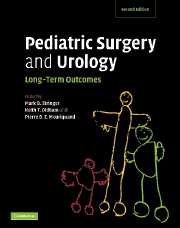Book contents
- Frontmatter
- Contents
- List of contributors
- Acknowledgments
- Preface
- Part I General issues
- Part II Head and neck
- Part III Thorax
- Part IV Abdomen
- Part V Urology
- 41 Introduction
- 42 Upper tract dilation
- 43 Posterior urethral valves
- 44 Vesicoureteric reflux
- 45 Genitoplasty in exstrophy and epispadias
- 46 Feminization (surgical aspects)
- 47 Hypospadias
- 48 Bladder exstrophy
- 49 Surgery for neuropathic bladder and incontinence
- 50 Non-neuropathic bladder–sphincter dysfunction
- 51 Undescended testes
- 52 Circumcision
- 53 The single kidney
- 54 Multicystic kidney
- 55 Urolithiasis
- 56 Gonadal tumors
- Part VI Oncology
- Part VII Transplantation
- Part VIII Trauma
- Part IX Miscellaneous
- Index
- Plate section
- References
46 - Feminization (surgical aspects)
from Part V - Urology
Published online by Cambridge University Press: 08 January 2010
- Frontmatter
- Contents
- List of contributors
- Acknowledgments
- Preface
- Part I General issues
- Part II Head and neck
- Part III Thorax
- Part IV Abdomen
- Part V Urology
- 41 Introduction
- 42 Upper tract dilation
- 43 Posterior urethral valves
- 44 Vesicoureteric reflux
- 45 Genitoplasty in exstrophy and epispadias
- 46 Feminization (surgical aspects)
- 47 Hypospadias
- 48 Bladder exstrophy
- 49 Surgery for neuropathic bladder and incontinence
- 50 Non-neuropathic bladder–sphincter dysfunction
- 51 Undescended testes
- 52 Circumcision
- 53 The single kidney
- 54 Multicystic kidney
- 55 Urolithiasis
- 56 Gonadal tumors
- Part VI Oncology
- Part VII Transplantation
- Part VIII Trauma
- Part IX Miscellaneous
- Index
- Plate section
- References
Summary
Introduction
Genitoplasty has been the traditional treatment for various forms of ambiguous genitalia and genotypical abnormalities. These conditions represent a spectrum of clitorophallic size and form, as well as vaginal position, size, and location. In some cases, complete absence of the genitalia must also be considered. Careful consideration of anticipated gender and function outcomes must be weighed before choosing some form of feminizing genitoplasty. Through the years, techniques, timing, and materials for genitoplasty have evolved, whereas surgical goals have remained unchanged.
The immediate goal is to provide the external genitalia with an esthetic and feminine appearance. The long-term goals are to produce a functional vagina of sufficient size for comfortable sexual intercourse, to retain sexually sensitive tissue to allow orgasm and, if internal genitalia permit, to preserve fertility potential. The surgeon's intent is to facilitate the patient's positive psychosocial adjustment throughout the patient's life. Sometimes, a completely satisfactory solution is not possible.
Even though techniques have advanced through the years, these demanding repairs and reconstructions are not without significant complications, necessitating careful multidisciplinary follow-up. Though genitoplasty presents many immediate problems and considerations, the most challenging are the long-term surgical outcomes. Many surgeons consider creating presentable external female genitalia with a sizable vagina an adequate outcome, but cosmetic appearance and passive sexual function is only one measure of success. Because scant knowledge exists, little is known about how adults adjust to genitoplasty or whether the genitoplasty expresses their sexual preference.
- Type
- Chapter
- Information
- Pediatric Surgery and UrologyLong-Term Outcomes, pp. 595 - 610Publisher: Cambridge University PressPrint publication year: 2006
References
- 1
- Cited by

